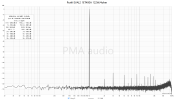Guddu
Major Contributor
- Joined
- Feb 10, 2020
- Messages
- 1,558
- Likes
- 1,543
What are the issues in using linear power supply (transformer + bridge rectifier assembly etc.) with class D amplifiers?
Idle energy loss too high?
Efficiency?
Magnetic field interferences?
Price?
Almost every established traditional brand (like Denon, Marantz, etc.) used linear PSU in their class D amplifiers.
Are there any benefits to do this?
Head room?
Dynamic performance?
“Let us learn from what you’ve learned”
Idle energy loss too high?
Efficiency?
Magnetic field interferences?
Price?
Almost every established traditional brand (like Denon, Marantz, etc.) used linear PSU in their class D amplifiers.
Are there any benefits to do this?
Head room?
Dynamic performance?
“Let us learn from what you’ve learned”


